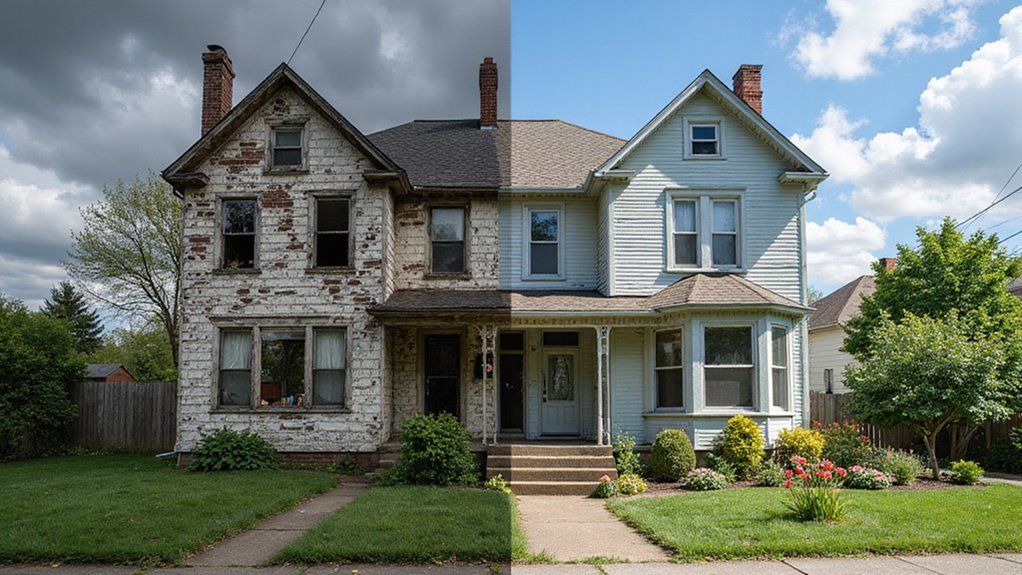Should You Sell As-Is or Make Repairs First?

Deciding whether to sell your home as-is or make repairs first is a big challenge. It affects your timeline and potential profit. Should you save effort and sell now, or risk delays for a better price? This choice can feel overwhelming with so much at stake.
The stress builds when you think about costs and time. Repairs might drain your budget without guaranteed returns. Selling as-is could mean lower offers or a longer wait. Uncertainty about market trends only makes this tougher. But don’t worry, there’s a way to decide wisely.
Weigh your finances and local market trends to choose smartly. Research buyer preferences and repair costs for clarity. With the right approach, you can maximize profit and minimize stress. This blog will guide you through this tough decision with clear, helpful tips.
Key Takeaways
- Selling as-is speeds up the sale process by avoiding repair delays.
- Repairs can increase sale price by enhancing property appeal.
- As-is sales may lower prices due to buyer-perceived risks.
- Repairs risk high costs and delays without guaranteed returns.
- Market conditions influence whether as-is or repairs suit best.
Can You Sell a House As-Is?
Yes, you can sell your house without any repairs. It’s a practical choice if certain conditions are met. Legally, you must follow local laws and disclose the home’s condition. Transparency helps avoid future legal issues or disputes.
Market trends also affect your sale. If demand is high, buyers might overlook flaws. In slower markets, they may want better homes. Research local patterns and consult an expert. This ensures you make a smart decision. Additionally, selling as-is can attract cash buyers and investors who often seek properties in any condition for quick transactions.
What does it mean by Selling "As-Is"?
When you sell a house "as-is," you're offering it in its current condition, with no promise to fix anything before the sale. You'll find benefits like saving time and money on repairs, but you’ve got to weigh that against possible drawbacks, such as a lower sale price due to buyer hesitation.
Let’s break down the specific pros and cons to help you decide if this route fits your goals. This approach often attracts cash buyers who are looking for quick transactions without the delays of mortgages or extensive inspections.
Pros of Selling a House As-Is
When you sell your house "as-is," you're offering it in its current condition, with no repairs or updates made before the sale. This approach can lead to a faster sale, lower costs, and less hassle, while also attracting investors who seek properties to renovate. Consider how these benefits—speed, savings, and simplicity—might outweigh the potential drawbacks of a lower offer.
Faster Sale
Selling your house "as-is" can speed up the process significantly. You avoid repair delays and attract quick buyers. If you use virtual staging, you show potential without fixing anything. Buyer incentives can make the deal even better. In a busy market, you’ll close faster. If buyers are eager, they’ll act sooner.
Lower Costs
Selling your house "as-is" saves money by skipping costly repairs. You avoid upfront expenses that strain your budget. This choice keeps your funds safe for moving costs. If you skip renovations, you gain financial flexibility. You can then focus resources on other urgent needs. This approach helps manage expenses during a tough transition.
Attracts Investors
Selling your house "as-is" can be a wise choice. It directly attracts investors seeking good deals. These buyers often want properties at lower prices. If you offer such incentives, they may show interest quickly.
Investors aim for portfolio growth through fixer-uppers. They see value in homes needing work. When you skip repairs, your property becomes a great opportunity. If they invest, they could renovate and earn profits.
Less Hassle
Selling your house "as-is" means less hassle for you. It avoids the stress of repair talks or tight deadlines. Your agent selection becomes easier since they won’t handle contractor problems.
If repairs aren’t needed, move planning stays simple and focused. You can prioritize your next steps without renovation delays. This process saves time and cuts down stress greatly.
Cons of Selling a House As-Is
When you sell your house as-is, you're likely to face a lower sale price since buyers factor in the cost of needed repairs. You'll also attract a limited buyer pool, as many won't want the hassle of fixing issues themselves. On top of that, expect negotiation challenges, as buyers often push for steeper discounts to offset the property's condition.
Lower Sale Price
Selling a house "as-is" often means getting a lower sale price. Buyers usually want discounts for homes needing repairs. They see "as-is" properties as risky, which lowers their offers. If repair costs are high, this reduced price might still save money. Weigh these factors carefully before making a decision.
Limited Buyer Pool
Selling a house "as-is" directly affects both the price and your buyer pool. It limits potential buyers to those ready for repairs. Many families and first-time buyers want move-in-ready homes instead.
If local economy weakens, fewer investors might show interest. Demographic shifts could also reduce DIY enthusiasts in your area. So, be aware that your market may shrink significantly.
Negotiation Challenges
Negotiating the sale of an as-is property can be tough. Buyers might doubt the home’s condition and your honesty. If trust is low, they could push for bigger discounts. Deadline pressures may force you to lower the price. If time is tight, you might agree to unwanted terms. Buyers often expect price cuts for hidden issues. If you lack proof of value, holding firm becomes hard.
Repair a House First. Get Listed and Sell It
When you choose to repair your house before listing it, you’re betting on a higher sale price, as a well-maintained property often attracts more buyers and justifies a premium. However, you’ve got to weigh the upfront costs and time investment against the potential return, since renovations don’t always guarantee a profit.
Let’s break down the pros and cons to see if this strategy fits your goals. Additionally, understanding your budget is key, as it defines financial limits for the scope of repairs or renovations you can undertake.
Pros
When you repair your house before listing it, you’re likely to secure a higher sale price due to the improved condition and appeal. These upgrades also broaden your buyer pool and speed up marketability, as a move-in-ready home attracts more interest and offers a competitive edge. Consider how these strategic fixes can position your property above others in a crowded market.
Higher Sale Price
Want to increase your home's value before selling? Start by making necessary repairs to boost its appeal. These fixes can raise the perceived worth, supporting a higher asking price. If you invest now, you could see a big return at closing.
Strategic upgrades make a difference in how buyers view your home. Highlight these improvements using smart appraisal strategies. Effective marketing tactics can also showcase your home’s true value. Don’t hesitate—spend on repairs if you want better offers.
Broader Buyer Appeal
A well-maintained home can attract a larger group of buyers. It appeals to first-time buyers and growing families alike. If you repair issues early, you make the home ready to move in.
This increases interest from different buyer types. Tailor your marketing to show the home’s excellent condition. Highlight its appeal to various groups for better reach. If done right, you could receive more offers in a tough market.
Faster Marketability
Repairing your home first speeds up the listing process. You can put it on the market right away. If you use virtual tours, buyers see the finished look instantly. Targeted digital ads also help reach many people fast. A move-in-ready home could sell quicker with these strategies.
Competitive Edge
Your home stands out in a busy market with the right preparation. Repairs before listing give you a clear advantage. A Market Analysis shows buyers prefer move-in-ready homes over outdated ones.
If you fix issues, your property grabs attention quickly. Offering a polished space becomes a top incentive for buyers. It draws serious offers and supports a higher price. In a tough market, this edge matters most.
Cons
When you choose to repair your house before listing it, you're immediately hit with upfront costs that can strain your budget. You'll also find the process incredibly time-consuming, as coordinating repairs often drags on longer than expected.
On top of that, unexpected expenses can arise, leaving you with financial surprises you didn't plan for.
Upfront Costs
Upfront costs can be a big challenge when repairing a house before selling it. You pay for everything first. Returns are not guaranteed, so think carefully.
- Material Costs: Quality supplies often come with a high price.
- Labor Fees: Hiring skilled workers can cost a lot.
- Unexpected Repairs: If hidden problems arise, your budget might suffer.
Time-Consuming
Repairs can delay selling your house significantly. They often take weeks or even months to complete. If speed is crucial, this waiting period might frustrate you. Contractors and project tasks can disrupt your daily life. Managing schedules also demands much effort and focus.
If you prioritize a quick sale, consider skipping major fixes. Delays could clash with your selling goals. Weigh if spending time on repairs is worth it. Your patience might be tested during this process. Decide based on your timeline and needs.
Unexpected Expenses
Unexpected expenses can disrupt your house repair plans before selling. These costs catch you off guard and strain your budget. Consider these potential risks:
- Hidden Damage: Mold or leaks might hide inside walls, increasing repair costs suddenly.
- Insurance Issues: If claims get denied, you could pay for damages yourself.
- Emergency Loans: Taking high-interest loans may cover costs but burden your finances.
Why As-Is Sell Is the Best Option
Selling your home as-is saves time and money by skipping costly repairs. You can list the property quickly and avoid delays. This method puts cash in your hand faster than renovating. If speed matters, this is your best choice.
As-is selling reduces stress by removing repair worries. It helps with asset liquidation, turning property into funds easily. Buyers may want a discount, but you save on costs.
If simplicity is key, consider this smart strategy. Additionally, this approach appeals to investors and flippers who often seek properties needing renovation for their projects.
Conclusion
In conclusion, deciding to sell your home as-is or make repairs depends on your situation. If you have time and money, repairs can increase your home’s value.
However, if you’re in a hurry, selling as-is may be best.
If repairs aren’t an option, consider companies that buy houses for cash. We at Tulsa Home Buyers offer quick solutions for homeowners. If you’re strapped for funds, this can work well.
Should you need a fast, stress-free sale, we’re here to help. Contact Tulsa Home Buyers today for an easy process. We’ll guide you through every step.
This is paragraph text. Click it or hit the Manage Text button to change the font, color, size, format, and more. To set up site-wide paragrapTulsa Home Buyers • May 7, 2025h and title styles, go to Site Theme.
Ready to work with Tulsa Home Buyers?
Let's connect! We’re here to help.
Send us a message and we’ll be in touch.
Or give us a call today at 111-222-3333


